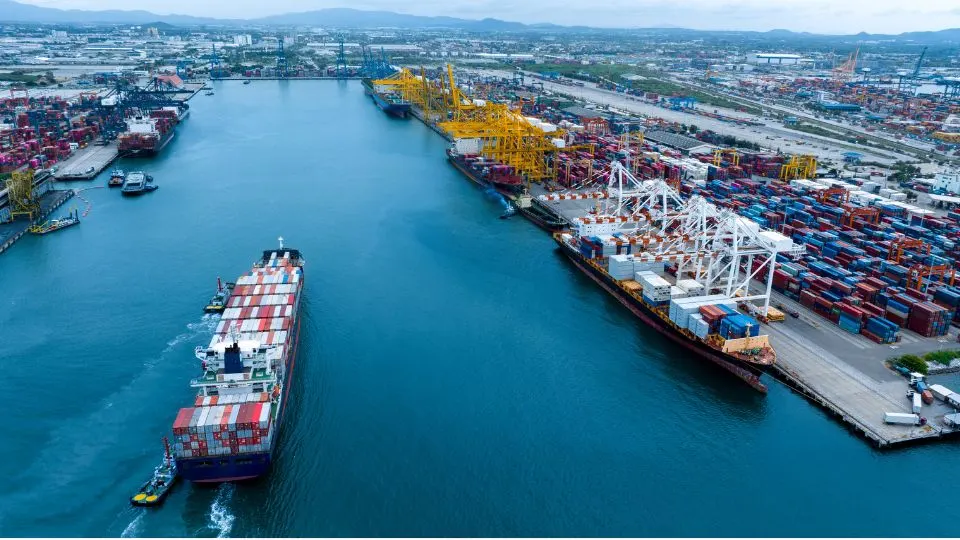Are you concerned about the rapidly changing ocean freight rates?
Do you find it difficult to forecast freight costs to your clients due to regular rate fluctuations?
Despite these uncertainties, you want to manage these fluctuating rates and offer your clients the best ocean freight costs.
In today’s competitive market, knowledge of freight rates can make or break your business.
With the right know-how, you can plan and manage your costs effectively, giving you a significant advantage over your competitors.
In this article, you’ll dive deep into ocean freight rates and explore key components. You will also understand how the shipping costs are calculated and interpreted.
First, let’s understand what ocean freight rates are and why it is important for your business.
What are Ocean Freight Rates?

Ocean freight rates, also known as ocean cargo rates, refer to the costs associated with transporting cargo via sea. These rates include various prices charged by the shipping lines for moving goods from one port to another.
Ocean cargo rates form the backbone of global trade, simultaneously affecting overall product pricing and supply chain.
Why is it Important for Your Business?
A clear understanding of shipping rates allows you to predict competitive and profitable prices for goods to your clients. It also helps you optimize your inventory levels, and decide your shipment frequencies.
Accurate freight costs are crucial for proper customs declarations and duty calculations. Building a deep understanding of ocean freight rates helps with compliance and offers you a competitive edge over your competitors. This ultimately boosts customer service quality and overall satisfaction.
So let us dive right into the key components used for calculating ocean right rates.
Key Components of Ocean Freight Costs

The various components that contribute to the total cost of ocean freight shipping are as below:
- Base Ocean Freight Cost: It is the basic cost charged for transporting a container from its origin to the destination port. It is usually quoted per cubic meter for LCL and per container for FCL shipments.
- Terminal Handling Charges (THC): THC is the fees imposed for loading and unloading of shipping containers at the port terminals.
- Inland Transportation Costs: As the name suggests, this is the cost of moving the containers to and from the port through inland transportation. This is applicable in case of door-to-door delivery situations.
- Surcharges: Along with base freight rates, the shipping companies levy additional costs like:
- Bunker Adjustment Factor (BAF) for fluctuations in fuel prices.
- CAF (Currency Adjustment Factor) for fluctuations in currency exchange rate.
- PSS (Peak Season Surcharge) is the additional fee charged during peak season demand.
- GRI (General Rate Increase) is the additional fee imposed by the shipping companies along with their standard cargo rates.
Now let’s examine the dynamic factors that fluctuate these ocean freight rates.
Factors Affecting Ocean Freight Rates and Costs

Now that you know the key elements of ocean freight rate, here’s the harsh truth. It isn’t as simple as it may sound. Ocean freight rates often seem like chasing a moving target. They keep fluctuating based on many different factors.
Here are some of the major ones:
1. Fuel Costs
Fuel prices significantly affect ocean freight rates. As fuel costs rise, shipping lines increase their freight rates to cover higher operating costs. This fluctuation often leads to slow vessel movement, as it helps the shippers to conserve more fuel.
To avoid risks of losing clients due to rising fuel costs, always consider bunker costs to negotiate favorable shipping rates.
2. Demand & Supply Economics
The relation between available cargo space and shipping demand directly impacts corresponding rates. When demand exceeds supply, prices increase, and vice versa.
3. Seasonal Variations
The holiday shopping season which normally spans between August to October, sees an increase in demand for container shipments, resulting in increased rates.
On the other hand, off-peak seasons may offer more competitive pricing due to less demand. In case you have to book shipments during off-peak season, make sure you explore all options available and then plan accordingly.
Pro tip: For the holiday or peak season, try booking your shipments in advance. Last-minute bookings always prove to be costlier.
4. Port Fees and Customs Duties
Various port-related charges such as Terminal Handling Charges (THC), Container Freight Station (CFS), and Vessel Traffic Service (VTS) fees contribute to the calculations of ocean freight rates. Ports with advanced facilities often charge higher fees.
In addition to port fees, shipping costs include customs duties, as the cargo crosses different ports and countries. Customs duties are based on the Harmonized System (HS) code of the goods.
Before quoting any rates, make sure you’re knowledgeable in the fee structures of the respective ports and regions. Always have alternative routing plans ready before offering quotes to the clients. That way, if something changes, you are not at the mercy of one specific route.
Equipped with this knowledge now we are ready to find out how to calculate total shipping rates.
This is where the rubber meets the road.
How are Ocean Freight Rates Calculated?

Ocean freight rates are determined by a combination following key factors:
- Container size and type
- Cargo volume and weight
- Origin and destination ports
- Current market conditions
The process of calculating total freight rates involves the following steps:
Step 1: Determine the base freight rate for the specified container type, then select a favorable routing plan.
Step 2: Add the applicable surcharges and fees to the base rate.
Step 3: For LCL shipments, don’t forget to include additional volume discounts and contract rates.
Step 4: Adjust the current market conditions and seasonal factors to the above cost derived.
Step 5: Include any special handling charges based on the nature of the cargo and fuel surcharges (BAF).
Step 6: Add currency adjustments, along with customs and documentation fees, if necessary.
Let’s try to understand the calculation of ocean freight rates with a practical example:
If the Base Rate for a 40ft container from Shanghai to LA is $2,000 and the additional charges are as mentioned below:
- BAF: $300
- THC (origin and destination): $400
- Documentation Fee: $50
- Security Fee: $25
- Peak Season Surcharge: $200
- Volume Discount: -$100
Then the total Ocean Freight Rate equals $2,875.
Make sure that you calculate these costs using freight forwarding software before negotiating favorable rates for the clients.
Strategies to Save on Ocean Freight Costs

“The secret of success is to do the common things uncommonly well.” – John D. Rockefeller Jr.
That quote from legendary entrepreneur John D. Rockefeller captures the essence of optimizing ocean freight rates.
By adapting and making simple changes, you can save considerable costs, retain profitability, and at the same time provide customer satisfaction.
Here are some strategies that can help you reduce ocean freight costs:
1. Choose the Right Incoterms
Select appropriate Incoterms to allocate costs and define responsibilities between buyers and sellers. This, in turn, helps in reducing overall shipping expenses.
For example, FOB (Free on Board) often allows for better cost control than CIF (Cost, Insurance, and Freight).
2. Consolidate Shipments to Reduce Costs
Combining multiple smaller shipments into one larger consignment can lead to significant cost savings, especially for Less than Container Load (LCL) shipments.
3. Choose Reliable Freight Forwarding Software
Using a freight forwarding software like SeaRates ERP can provide valuable insights on cost-effective routing options thereby optimizing ocean freight rates.
4. Cost Management
Implementing a digital freight forwarding solution can help in tracking costs, identifying inefficiencies, and making data-driven decisions to optimize shipping expenses.
5. Flexible Shipping Schedules
Always have alternate shipping schedules ready. That way, you can avoid slow transit problems during peak seasons. You can also opt for slow transit options as they offer lower freight rates.
6. Negotiate for Better Terms and Rates
You can also use your strong relationships with different carriers to negotiate the best available shipping rates. First, compare rates offered by multiple carriers. Then select the shipment that offers the best freight rates. Also, clarify and get agreement on guaranteed allocation of space during tight space situations to avoid any hassles during transit.
7. Alternative Transit Modes
Ocean freight is generally the most cost-effective option for large-volume shipments over long distances.
You can always consider alternative transport modes like air freight for more time-sensitive shipments. You can also opt for rail freight for overland transport, especially in regions with developed rail networks.
These strategies will not only help you in optimizing favorable cargo rates but also improve your overall profit.
To demonstrate how a simple change can lead to big cost savings, let’s take a look at the success story of Procter & Gamble.
Case Study: Procter & Gamble’s Supply Chain Optimization

Strategy: P&G implemented a comprehensive supply chain optimization program.
Actions Taken:
- They initially cut down the number of ocean carriers from 250 to 10.
- Then they combined the shipments to ensure the best use of available containers.
- Implemented high-end forecasting tools to predict demand more accurately.
After implementing this approach, they were able to save over $600 million annually in logistics costs. This, in turn, enhanced their on-time delivery performance by 8%, besides reducing inventory levels by 5%.
From the P&G case study, we can learn that by consolidating carriers and improving forecasting, we can make significant cost savings, in addition to improving daily business operations.
Conclusion
Understanding ocean freight rates is essential for any business engaged in international trade.
So far, we looked at various dynamic factors that can impact ocean freight rates. We also looked at the cost-saving strategies to stay competitive and provide the best value to your clients.
As the shipping industry continues to evolve, it is also imperative to keep up with changes. Most important is the area of environmental regulations, such as the IMO 2020 sulfur cap.
Staying informed about the market trends and applying the strategies mentioned in this article, will allow you to optimize shipping rates and help you make informed decisions.
One of the best ways to optimize your ocean freight rate cost is to embrace a digital freight forwarding solution.
Freight forwarding software like SeaRates ERP can automate and optimize your ocean freight costs with ease.
So go ahead and embrace technology to boost your efficiency and profitability.
Frequently Asked Questions
1. What factors influence ocean freight rates?
The key factors that influence shipping rates are fuel costs, supply and demand dynamics, seasonal variations, and port-related charges.
2. How can I calculate ocean shipping costs?
To calculate Ocean shipping costs, you can choose a freight forwarding software like SeaRates ERP which includes freight rate calculating tools and automated quote generation for client shipments.
3. How do ocean freight rates differ across regions?
Ocean freight rates can vary significantly across regions due to factors such as trade imbalances, port infrastructure, and local economic conditions. Routes with high demand or limited capacity typically have higher rates.








